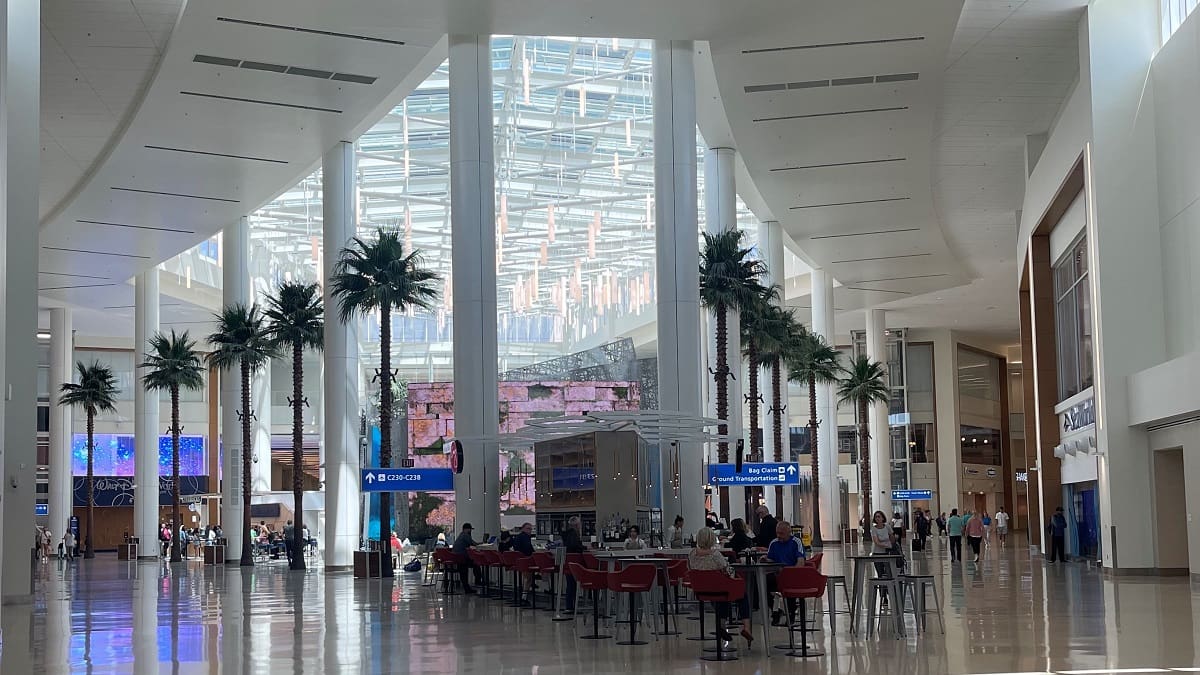With hundreds of miles of fiber cabling, Terminal C at Orlando International Airport chooses Passive Optical LAN to enable their vision of a modern transportation hub of the future – How did they reach this decision and what process did they follow to ensure success?
The top priorities for Orlando International Airport’s new Terminal C are safety, security, sustainability, traveler experience (including retail and dining), and technology innovation to create a modern transportation hub of the future.
To accomplish this goal, Orlando International Airport is piloted by the Greater Orlando Aviation Authority, which is governed by a seven-member board. The airport is operated by the Chief Executive Officer, who is appointed by GOAA, and has staff of nearly 850 full-time employees.
 With technology innovation at the forefront of the Orlando International Airport Terminal C project, GOAA chose Tellabs® Optical LAN for its tangible impact on their key vision of safety, security, sustainability, and superior user experience.
With technology innovation at the forefront of the Orlando International Airport Terminal C project, GOAA chose Tellabs® Optical LAN for its tangible impact on their key vision of safety, security, sustainability, and superior user experience.
The successful process that GOAA followed to select Tellabs Optical LAN can be categorized into these decision criteria.
- Choosing a Technology
- Designing the Network
- Specification, Test and Selection
- Implementation and Operations
Choosing a Technology
Passive Optical Networks, or PONs, are a popular technology choice for airports due to their cost-effectiveness. Yet for GOAA, there were clear advantages for fiber-based network such as its positive impact on easier operations, better reliability, improved sustainability, plus strong security that matched the airport’s modern vision.
Easier operations – Optical Local Area Networks (LAN) that use PON as the underlying technology simplify the architecture and management of the network. The design has Optical Line Terminals (OLT) centralized in secure locations, to reduce the need for large communications rooms and optical-to-electrical media converters called Optical Network Terminals (ONT). ONTs are unmanaged and highly reliable devices. Network management is defined in software using global profiles for more machine-to-machine type actions that allow dynamic orchestration based on real-time needs. This all translates to limited human touch, which results in easier operations for the airport IT staff.
Improved Sustainability – Optical LAN delivers quantifiable benefits to healthy, green, and smart airport design. They have proven to be more energy-efficient, environmentally friendly, require less space on floors, racks, risers, pathways, and communications rooms. By choosing PON technology, airports can reduce their consumption of materials (e.g., less copper and plastics), and even better, the future scalability of optical networks results in extended longevity and cradle-to-grave system lifecycle.
Strong Security – Optical LAN removes known network security gaps (e.g., a significant reduction in user management access and IP addresses). A fiber-based network utilizing PON technology presents a smaller network attack surface, and is ideal for zero trust architecture, as it requires less human touch to manage. Fiber optic cabling is also inherently more secure than copper cabling. Fiber cabling is not susceptible to interference, nor does it introduce interference. With optical cabling, there is no crosstalk, no EMI, no RFI, and no EMP. By implementing technology with the highest degree of security, the airport contributes directly to the safety of the passengers and their staff.
“As manager of infrastructure, I oversee the server team, the network team, and the structured cabling team. We manage over several thousand miles of fiber. So with that in mind, how do we benefit from all that fiber? The answer is by innovating with Passive Optical Networking,” said Paul R. Haust, Greater Orlando Aviation Authority IT Infrastructure Manager.
Designing the Network
The network design for Terminal C benefited greatly from a fiber-based architecture. The Optical LAN offered flexibility that helped shift real estate, which was normally monopolized by network needs, to revenue-generating leased space. PON also offered economical fiber route redundancy, services, and equipment protection in the event of network downtime. It also provided optimal scalability to keep pace with the contemporary traveler experience that GOAA wanted to exemplify and expected future growth.
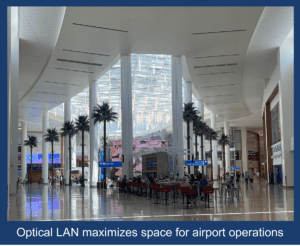 Reduce Network Footprint– With PON, there is less cabling, smaller pathways, and fewer communication rooms required. This frees up more space for travelers, tenants, vendors, and airport operations. Communication rooms are distribution points where cables from various rooms, floors, and buildings are terminated. This is where legacy network devices such as traditional switches and routers are positioned. By reducing the number of communication rooms required, an Optical LAN can save valuable space that can be leased out to tenants or used for other airport operational purposes. The ability to reduce the network imprint and repurpose that area to leasable space was a positive financial benefit to GOAA.
Reduce Network Footprint– With PON, there is less cabling, smaller pathways, and fewer communication rooms required. This frees up more space for travelers, tenants, vendors, and airport operations. Communication rooms are distribution points where cables from various rooms, floors, and buildings are terminated. This is where legacy network devices such as traditional switches and routers are positioned. By reducing the number of communication rooms required, an Optical LAN can save valuable space that can be leased out to tenants or used for other airport operational purposes. The ability to reduce the network imprint and repurpose that area to leasable space was a positive financial benefit to GOAA.
“One of the benefits we see is that we don’t have the copper limitation, so we don’t have to take up as much space (using Optical LAN) with communication rooms. It’s paramount that we are able to provide needed space to tenants and to vendors. So, we decided that, OK, we will go with the PON,” stated Haust.
Better Reliability – The ease of operation, fewer human touches, and reduced number of communications rooms translate to fewer points of failure, thus making PON a more reliable architecture. Additionally, there is design flexibility with an Optical LAN that can build additional protection into the underlying connections and services. For example, Terminal C infrastructure was implemented with PON protection which means fiber route redundancy, redundant geo-graphically dispersed electronics, services diversification, and end-to-end network path health protection switching.
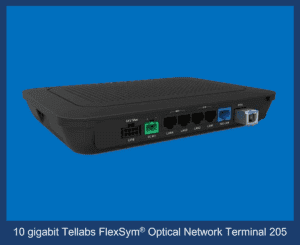 Contemporary Traveler Experience, including Future Growth – PON used for enterprise networks is a newer technology compared to traditional copper networks, which means it is continually evolving and improving. This was an attractive option for Orlando International Airport looking to invest in a network that can support its current and future needs. For Terminal C, the design called for an end-to-end 10-gigabit PON connecting multi-gigabit Ethernet at 1 gigabit, 2.5 gigabit, 5 gigabit, and even 10-gigabit choices. As the technology advances, Optical LAN will likely become even more cost-effective and scalable for airports with its support of wavelength division multiplexing, and its ability to add additional 10-gigabit wavelengths or 40 gigabit or 100 gigabits over today’s existing fiber infrastructure.
Contemporary Traveler Experience, including Future Growth – PON used for enterprise networks is a newer technology compared to traditional copper networks, which means it is continually evolving and improving. This was an attractive option for Orlando International Airport looking to invest in a network that can support its current and future needs. For Terminal C, the design called for an end-to-end 10-gigabit PON connecting multi-gigabit Ethernet at 1 gigabit, 2.5 gigabit, 5 gigabit, and even 10-gigabit choices. As the technology advances, Optical LAN will likely become even more cost-effective and scalable for airports with its support of wavelength division multiplexing, and its ability to add additional 10-gigabit wavelengths or 40 gigabit or 100 gigabits over today’s existing fiber infrastructure.
“It was newer technology back then. It is not now, but back then, eight years ago when we first investigated PON, it was. And this became the foremost portion of the Terminal C network design,” said Haust.
Specification, Testing and Selection
To create an ideal framework for this Optical LAN modern airport terminal project, a detailed requirements document was developed by a committee comprised of IT, network engineers, and architects. The specification defined what was wanted, how it was intended to be operated, what services were to be connected, and support and maintenance expectations. The comprehensive document included:
Project Scope: The document outlined the areas, systems and services of the terminal that the fiber-based network infrastructure would connect.
Technical Requirements: The document specified the technical requirements for the PON design, including the bandwidth required, the number of drops required, and the distance that data could be transmitted.
Testing Criteria: Test criteria were developed and documented to guarantee that all vendors would be graded against the same items during the vendor “bake-off.” This document specified the criteria for testing the phone systems, access control, video surveillance, common use (e.g., methodology for allowing gates to be used by multiple airlines), dynamic signage, IP video, and others.
To select the best PON manufacturer for the Terminal C project, the following steps were taken by GOAA:
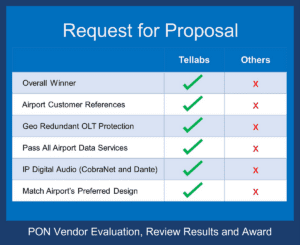 Request for Proposal (RFP): RFPs were distributed to various respected PON manufacturers, their submissions received back, and their responses were reviewed.
Request for Proposal (RFP): RFPs were distributed to various respected PON manufacturers, their submissions received back, and their responses were reviewed.
Shortlisting: Three PON vendors were shortlisted after evaluating and ranking their competent responses to the RFP.
Vendor Evaluation: The three shortlisted vendors were invited to demonstrate their products in-house during a side-by-side evaluation. Each vendor was given an identical sample architecture to configure and price. The testing criteria document was used to assess and grade the vendors fairly.
Additional Factors: The team took note of “nice-to-haves” that were not part of the testing document. These factors would be used to aid decision making, should tie-breakers be needed. For example, Tellabs provided proof of their support of CobraNet. Cobranet is an IP-audio networking protocol that is used for airport paging systems and is of critical importance for smooth operations.
Review Results and Award: The award was based on value and points as reviewed by the committee. The committee selected Tellabs as the winner based on value, and highest number of points scored during the actual test. The selection committee then had to make a presentation to the GOAA Board, which resulted in the unanimous decision to award the Terminal C PON project to Tellabs.
“We added all of that up and Tellabs was chosen to be our top contender by the evaluation staff. And then this went to our Board,” commented Haust. “We had to do a presentation to the Board as to why we chose Tellabs. And then the Board unanimously agreed that Tellabs was the best choice to bring in.”
Implementation and Operations
Once Tellabs Optical LAN was chosen as the PON equipment of choice for Terminal C, an in-house integration lab was built to confirm that the new network infrastructure was tested and validated before being rolled out in the live airport environment. The integration lab was also used for training airport staff to gain the necessary skills and knowledge to manage and maintain the new network system.
Next, GOAA selected a local fiber network installer and integrator, Precision Contracting Services (PCS).
Now with this newly formed team of GOAA, Tellabs, and PCS in place, Terminal C finalized the design for both the landside (e.g., before security checkpoint) and airside (e.g., beyond security checkpoint) areas of the terminal.
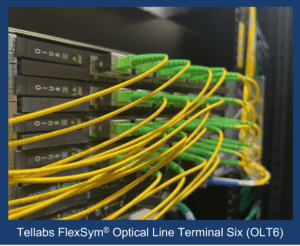 The Tellabs Optical LAN system was made redundant between these critical areas. Two Tellabs FlexSym® Optical Line Terminal Six (Tellabs FlexSym OLT6) served landside, and two Tellabs FlexSym OLT6 served airside, connecting over 4,000 Ethernet connected devices with idle future capacity for growth to 8,000 Ethernet connections. If one OLT experienced an upstream or downstream outage, it has the full capacity to protection switch over to an optimal second OLT without any noticeable downtime – this is all possible with Tellabs® Advanced Availability Software Package.
The Tellabs Optical LAN system was made redundant between these critical areas. Two Tellabs FlexSym® Optical Line Terminal Six (Tellabs FlexSym OLT6) served landside, and two Tellabs FlexSym OLT6 served airside, connecting over 4,000 Ethernet connected devices with idle future capacity for growth to 8,000 Ethernet connections. If one OLT experienced an upstream or downstream outage, it has the full capacity to protection switch over to an optimal second OLT without any noticeable downtime – this is all possible with Tellabs® Advanced Availability Software Package.
“We deployed four OLTs. Two landside and two airside. Each of these OLT pairs is configured so that if one set of pairs goes down, the other set can run the entire Terminal C on its own. And we have tested that, and it works flawlessly,” said Haust.
Two different types of 10-gigabits PON ONTs were chosen for their mounting and connectivity flexibility, the 5 Ethernet port Tellabs FlexSym® Optical Network Terminal 205 (Tellabs FlexSym ONT205) and 48 Ethernet port Tellabs FlexSym® Optical Network Terminal 248 (Tellabs FlexSym ONT248).
FlexSym ONT205: The FlexSym ONT205 offers five ports of Power over Ethernet (PoE) enabled Ethernet and multiple deep fiber mounting options. The Tellabs FlexSym ONT205 provides flexible and symmetrical extended Ethernet connectivity over a 10-gigabit passive optical network at multi-rate 1G, 2.5G, 5G, and 10G Ethernet speeds. The ONT205 offers flexible mounting on walls, floors, ceilings, even in plenum space, hidden inside office furniture, behind the facade, on top or underneath desks.
 FlexSym ONT248: The rack-mountable one-rack unit (1RU) FlexSym ONT248 offers the delivery of 48-ports of Ethernet connectivity over a 10-gigabit passive optical network. The FlexSym ONT248 has the power delivery capacity to support 60W PoE across all 48 ports. It offers economical one-to-one traditional closet-based switch replacement while gaining all the benefits of an Optical LAN (i.e., simple, secure, sustainable, and superior user experience).
FlexSym ONT248: The rack-mountable one-rack unit (1RU) FlexSym ONT248 offers the delivery of 48-ports of Ethernet connectivity over a 10-gigabit passive optical network. The FlexSym ONT248 has the power delivery capacity to support 60W PoE across all 48 ports. It offers economical one-to-one traditional closet-based switch replacement while gaining all the benefits of an Optical LAN (i.e., simple, secure, sustainable, and superior user experience).
This end-to-end Optical LAN system feeding the entire Terminal C is an ITU-T G.9807 compliant symmetrical 10 Gbps downstream, and 10 Gbps upstream, XGS-PON transmission. This makes Orlando International Airport the first airport to take advantage of high-speed connectivity using 10-gigabit PON technology.
GOAA also purchased additional equipment that allowed for 10% spares. This protected the airport against global supply chain issues and assured local access to parts to speed up maintenance issues.
Additional on-site training was provided to airport staff, including the IT and Networking teams. The airport personnel worked alongside PCS and Tellabs to gain the necessary experience and knowledge. It was important for Tellabs and PCS to be able to work side-by-side with the airport staff at a comfortable level so that everyone knew the products and how the system worked. The on-site training covered the following topics:
- PON system installation and configuration
- Network monitoring and management
- Troubleshooting and fault resolution
To ensure the smooth operation and maintenance of the new Optical LAN equipment, GOAA has established support agreements with both Tellabs and PCS. Tellabs provides overarching ongoing support and maintenance for the Optical LAN system, while PCS provides on-site and day-to-day support.
Since the implementation of the Optical LAN infrastructure, there have been minor configuration issues that were quickly resolved by Tellabs and PCS. The training of staff has also been ongoing to make sure that they are equipped to handle any issues that may arise.
“Tellabs’ support is great, but we also needed to make sure that we had feet on the ground. We had bodies that we could get to, and they could help. We’re in the Orlando area, so we also set up support with PCS. They provided us a tremendous service for installation,” remarked Haust. “PCS was the ultimate choice for the local to bring in and we have set up a support agreement with both PCS and Tellabs. PCS handles most of the onsite work, but Tellabs is there if needed. Tellabs does a lot of upgrades and PCS lets them lead with that. So, it’s together. A very close support model that we have set up for that now.”
What’s Next?
 Orlando International Airport Terminal C is currently looking towards the next phase of this terminal as they expand operations by adding additional gates. There is potential for expanding the fiber-based network to the existing terminal since an Optical LAN can connect users and devices miles away across fiber cabling.
Orlando International Airport Terminal C is currently looking towards the next phase of this terminal as they expand operations by adding additional gates. There is potential for expanding the fiber-based network to the existing terminal since an Optical LAN can connect users and devices miles away across fiber cabling.
To safeguard that the Optical LAN infrastructure remains up-to-date and meets the airport’s evolving needs, the airport plans to review Tellabs’ new technologies and opportunities. This will allow the airport to identify and leverage new capabilities that may be beneficial to the airport and its operations.
Tellabs Optical LAN, and PON technology, proves to be the ideal network architecture in support of Terminal C that prioritizes safety, security, sustainability, customer experience (including retail and dining) and technology innovation to create a modern transportation hub of the future. The airport is gaining tangible benefits from the extended distance of fiber-based connectivity, which allows for the reduction of communications rooms, and the ability to shift that real estate to leasable space for tenants and vendors.
“We felt that a Passive Optical Network would be the best way to showcase the new technology that we were implementing in Terminal C,” stated Haust. “The decision to choose PON was probably the best choice we could have made for the Terminal’s network.”
Overall, the implementation of the Tellabs Optical LAN at Orlando International Airport Terminal C has been a success, providing the airport with a more efficient and scalable network design. Ongoing support and training, as well as the review of new technologies and opportunities, will make certain that the Optical LAN infrastructure continues to exceed the airport’s needs and remains an integral part of its modern innovative vision for many decades to come.
